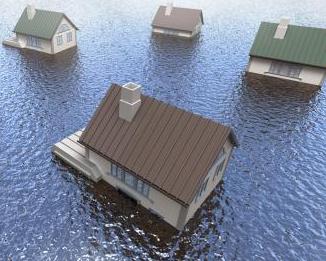 Floods can happen anywhere, in all 50 states, with the risk coming from a variety of causes.
Floods can happen anywhere, in all 50 states, with the risk coming from a variety of causes.
Even those who don’t live next to a water source could be at risk from a springtime deluge, rapid snowmelt or a flash flood caused by rainfall or a levee break.
In the spring the greatest risk is typically from rising water due to snow melt or heavy rains associated with thunderstorms.
Additional risk comes from hurricanes, which can bring flooding to areas along the coast and much farther inland, as demonstrated last year by Hurricane Sandy.
Even home or business owners who might not think they’re at risk should consider just how much of a threat a flood might offer and ways to reduce it, according to the Insurance Institute for Business & Home Safety.
Average annual flood losses in the U.S. during the past 10 years (2002 to 2011) totaled more than $2.9 billion, according to the National Flood Insurance Program.
“Unfortunately, every year homes and businesses across the U.S. are damaged or destroyed by floodwaters,” Julie Rochman, IBHS president and CEO, said in a statement. “While elevating properties or relocating outside of flood zones are the most effective ways to protect against damage from flooding, other things that can effectively reduce the risk of severe damage.”
The first step toward preparing for flooding is evaluating your flood risk. Knowing the Base Flood Elevation for a property is essential. The BFE refers to the level water will reach during what is often referred to as a “100-year event”; that it, such an event has a one percent annual chance of occurring in any given year.
“It is important to note that a 100-year event does not mean that this type of flood will happen only one time in a hundred years,” Rochman said. “The chances of such a flood occurring actually resets every single year, so a 100-year event has a one percent chance of happening every single year. If you have a 30-year mortgage, this means you have a 30 percent chance of seeing your home flood during the life of that mortgage.”
To fully understand the flood vulnerability of a particular location, property owners can compare the finished floor elevation with up-to-date flood map for that particular area. Community Flood Insurance Rate Maps are available through the FEMA Map Service Center website. Tips and step-by-step instructions for determining flood risk are available through the IIBHS website.
Property owners also should check building department records or the property survey for the elevation of the structure’s lowest floor or enclosed area in the building, including any space below ground level on all sides, such as a basement. If this information cannot be found, a licensed surveyor could be hired to make that determination.
IBHS recommends that homeowners take the following steps now, before a flood threatens, to reduce interior water damage:
• Keep drains, gutters and downspouts clear of debris.
• Inspect sump pumps and drains regularly to ensure proper operation.
• Have a licensed electrician raise electric components at least 12 inches above the expected flood levels.
• To prevent sewage backup, have a licensed plumber install an interior or exterior backflow valve.
• Make sure a yard’s grading (slope) directs water away from the building.
• Have the furnace, water heater and other permanent equipment raised so that they are elevated above the expected flood levels.
• Prepare an evacuation plan with a kit that includes insurance documents, medications and critical items in case there’s a need to evacuate for a few days.
IBHS recommends that commercial property owners take the following steps now, before a flood threatens, to reduce interior water damage:
• Talk with an insurance agent to make sure you have adequate flood insurance.
• Evaluate the drainage of the property to make sure the ground slopes away from the building and consider adding a waterproof membrane to the wall where leaks have occurred.
• Install watertight shields over all openings (including windows and doors) to a height at least 12 inches above the anticipated flood level.
• Install backflow valves. Backflow valves should be installed on main waste drain pipes that leave the structure or that are connected to equipment that is below the potential flood level. Valves may be needed on washing machine drain lines, laundry sinks, fuel oil lines, rain downspouts and sump pumps, as well as sewer/septic connections.
• Use a high-quality, urethane-based caulk to seal cracks and utility pipe penetrations through the exterior walls of your building.
• Be sure that any active water management system elements, such as sump pumps and wastewater lift stations, are hard-wired to the back-up generator in the event of a power failure. Test the back-up power system regularly. Install a back-up sump pump for buildings at risk for flooding.
• Raise at least 12 inches above the anticipated flood level or provide reliable flood protection enclosures such as shields, gates, walls, for electrical system components, transformers and switchgear, fire pumps, backup power sources such as generators and outdoor air conditioning systems.
• Properly anchor fuel tanks, such as LPG tanks, to help prevent the tank from breaking free and fuel from contaminating the building.
• Keep a supply of sandbags or water/sand filled barriers on hand to help divert unusually high water away from the building foundation.
• Establish clear snow removal guidelines that protect drains and the building foundation. If necessary, flag drains to avoid plowing snow on top of them.
• Prepare an evacuation kit with important papers, insurance documents and other things that might be needed if forced to evacuate a business for several days.












